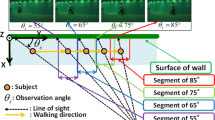Abstract
This chapter reports some novel experiments which assess the potential of footsteps as a biometric. We present a semi-automatic capture system and report results on a large database of footstep signals with independent development and evaluation data sets comprised of more than 3000 footsteps collected from 41 persons. An optimisation of geometric and holistic feature extraction approaches is reported. Following best practice we report some of the most statistically meaningful and best verification scores ever reported on footstep recognition. An equal error rate of 10% is obtained with holistic features classified with a support vector machine. As an added benefit of the work, the footstep database is freely available to the research community. Currently, the research focus is on features extraction on a new high spatial density footsteps database.
Access this chapter
Tax calculation will be finalised at checkout
Purchases are for personal use only
Preview
Unable to display preview. Download preview PDF.
Similar content being viewed by others
References
S.U.: Footstep recognition at Swansea Universtity available at. http://eeswan.swan.ac.uk
Vera-Rodriguez, R., Evans, N.W.D., Lewis, R.P., Fauve, B., Mason, J.S.D.: An experimental study on the feasibility of footsteps as a biometric. In: Proceedings of 15th European Signal Processing Conference (EUSIPCO’07), Poznan, Poland (2007) 748–752
Addlesee, M.D., Jones, A., Livesey, F., Samaria, F.: The ORL active floor. IEEE Personal Communications. 4 (1997) 235–241
Orr, R.J., Abowd, G.D.: The smart floor: A mechanism for natural user identification and tracking. In: Proceedings of Conference on Human Factors in Computing Systems. (2000)
Cattin, C.: Biometric Authentication System Using Human Gait. Swiss Federal Institute of Technology, Zurich. PhD Thesis. (2002)
Yun, J.S., Lee, S.H., Woo, W.T., Ryu, J.H.: The user identification system using walking pattern over the ubiFloor. In: Proceedings of International Conference on Control, Automation, and Systems. (2003) 1046–1050
Suutala, J., Roning, J.: Combining classifiers with different footstep feature sets and multiple samples for person identification. In: Proceedings of International Conference on Acoustics, Speech, and Signal Processing (ICASSP). 5 (2005) 357–360
Middleton, L., Buss, A.A., Bazin, A.I., Nixon, M.S.: A floor sensor system for gait recognition. In: Proceedings of Fourth IEEE Workshop on Automatic Identification Advanced Technologies (AutoID’05). (2005) 171–176
Gao, Y., Brennan, M.J., Mace, B.R., Muggleton, J.M.: Person recognition by measuring the ground reaction force due to a footstep. In: Proceedings of 9th International Conference on Recent Advances in Structural Dynamics. (2006)
Suutala, J., Roning, J.: Towards the adaptive identification of walkers: automated feature selection of footsteps using distinction-sensitive LVQ. In: Proceedings of International Workshop on Processing Sensory Information for Proactive Systems. (2004) 61–67
NIST: Speaker recognition evaluation website. http://www.nist.gov/speech/tests/spk/index.htm
Vapnik, V.N.: Statistical Learning Theory. Wiley, New York
Burges, C.J.C.: A tutorial on support vector machines for pattern recognition. Data Mining and Knowledge Discovery. Springer. 2(2) (1998) 1–47
Martin, A., Doddington, G., Kamm, T., Ordowski, M., Przybocki, M.: The DET curve in assessment of detection task performance. In: Eurospeech. 1 (1997) 1895–1898
NIST: Det-curve software for use with matlab. Available at http://www.nist.gov/speech/tools
Jolliffe, I.T.: Principal Component Analysis. Springer Series in Statistics. (2002)
Author information
Authors and Affiliations
Corresponding author
Editor information
Editors and Affiliations
Rights and permissions
Copyright information
© 2009 Springer-Verlag London Limited
About this chapter
Cite this chapter
Rodríguez, R.V., Mason, J.S., Evans, N.W. (2009). Assessment of a Footstep Biometric Verification System. In: Tistarelli, M., Li, S.Z., Chellappa, R. (eds) Handbook of Remote Biometrics. Advances in Pattern Recognition. Springer, London. https://doi.org/10.1007/978-1-84882-385-3_13
Download citation
DOI: https://doi.org/10.1007/978-1-84882-385-3_13
Publisher Name: Springer, London
Print ISBN: 978-1-84882-384-6
Online ISBN: 978-1-84882-385-3
eBook Packages: Computer ScienceComputer Science (R0)




